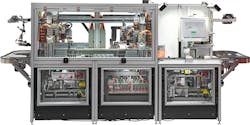5 Key Factors for IoT Devices
Download this article as a .PDF
The ultimate goal of the Internet of Things (IoT), whether it is Industry 4.0 or Smart Manufacturing, is to improve a manufacturer’s speed, flexibility, individualization of products, efficiency, and scalability of production. As IoT continues to influence the engineering industry, Bosch Rexroth in a recent white paper listed the five key factors of product design that will operate in the IoT world.
Decentralized Intelligence
A decentralized intelligence or distributed intelligence system is one where the machines connect and network each other with decentralized autonomy. The control capabilities and machine logic are located at the machine level. This provides them with the ability to process data and improve the machine process on their own rather than depend solely on a single computing source, whether it is a traditional wired network or cloud network.
These machines are still connected to plant- and enterprise-level networks, but being decentralized gives them the capacity to make in-the-moment decisions for specific events. For example, the technology can be used on drive-based controls. Drive-integrated servo motors and cabinet-free drive systems, which place drive components and motion logic sequencing at individual axis, are perfect examples of this type of system.
Rapid Connectivity
These devices that are part of a decentralized system need the ability to connect rapidly to the enterprise network. Data needs to flow freely to continue investment and improvement. Networks in the industrial space need to have several access points vertically to the central production servers, as well as horizontally between production nodes and machines. These networks need to be secure and written to open-software standards. Using open standards allow devices from different manufacturers the ability to connect to the same network and interact with each other.
Open Standards
The use of open standards in IoT devices allow for these devices to connect easily and quickly to different software architectures. This provides flexible integration of software-based solutions and the ability to easily migrate new technologies and devices into existing automation structures. An example would be a machine tool or packaging device allowing for easy connection for smart devices to obtain data or access to the controls. Open software standards allow for integration with modern modeling software. This helps in the creation of virtual models like the digital twin to achieve efficiency and maintenance prior to build.
Real-Time Context Integration
Real-time data collection is necessary for IoT devices. Devices need to be able to provide not just historical data but also instant data. This data, like throughput rates, machine downtime, energy consumption, or fault notifications, help provide engineers with information to perform predicative maintenance and process improvements.
Autonomous Behavior
Autonomous behavior will be key going forward in the world of Big Data. The goal is to create workspaces that can adapt to individual customer or product needs without the direct intervention of human operators—e.g., implementing an RFID tag on a product that can be recognized by different workstations along the production route. The workstations would adapt the work needed and the tool settings depending on the part recognition.




